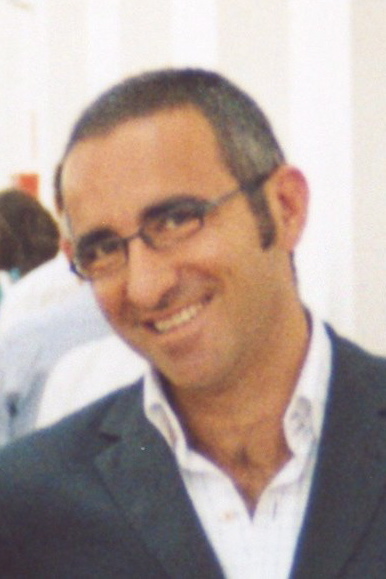
Alin Albu-Schäffer
Soft Robotics Manipulation: from torque-controlled to variable compliance robots
ABSTRACT
In order to interact with unknown environments and with humans, the DLR robots have design and control features which distinguish them substantially from classical, position controlled industrial robots. Light-weight design, high system complexity, including more than 50 motors per robot, nonlinear compliance elements, rich sensor capabilities (position, torque, vision) characterise these control plants, requiring new control strategies for high performance control.
Inspired by the human musculo-skeletal system, antagonistic, variable compliance actuators are a very active area of research, asking for new control approaches and providing an exciting new link to neuroscience by trying to understand and mimic human .motor control algorithms.
The approaches are used in space, service, medical and in new type of industrial robotics applications.
I will present the main design and control ideas of actively controlled compliant systems and of VIA robots using as examples the DLR arms, hands, the humanoid manipulator Justin and the DLR VIA hand-Arm System.
BIO
Alin Albu-Schäffer graduated in electrical engineering at the Technical University of Timisoara, in 1993 and got the PhD in automatic control from the Technical University of Munich in 2002. Since 2012 he is the head of the Institute of Robotics and Mechatronics at the German Aerospace Center, which he joint in 1995 as a PhD candidate.
Moreover, he is a professor at the Technical University of Munich, holding the Chair for “Sensorbased Robotic Systems and Intelligent Assistance Systems” at the Computer Science Department. The DLR robotics institute is one of the largest and most acknowledged labs worldwide in the area of space and assistance robotics, including industrial and medical applications. His personal research interests include robot design, modeling and control, nonlinear systems, flexible joint and variable compliance robots, impedance and force control, physical human-robot interaction, bio-inspired robot design. He received several awards, including the IEEE King-Sun Fu Best Paper Award of the Transactions on Robotics in 2012, several ICRA and IROS Best paper Awards as well as the DLR Science Award.
Domenico Prattichizzo
Connecting humans and robots through wearable haptics
ABSTRACT
The complexity of the world around us is creating a demand for interfaces that will simplify and enhance the way we interact with the environment. In this talk we will present the scientific and technological foundations for wearable haptics, a novel concept that will change the way humans will cooperate with robots. This research stems from the need for wearability which is a key element for natural interaction.

Oussama Khatib
Robots, the New Generation
ABSTRACT
Robotics is rapidly expanding into the human environment and vigorously engaged in its new emerging challenges. From a largely dominant industrial focus, robotics has undergone, by the turn of the new millennium, a major transformation in scope and dimensions. This expansion has been brought about by the maturity of the field and the advances in its related technologies to address the pressing needs for human-centered robotic applications. Interacting, exploring, and working with humans, the new generation of robots will increasingly touch people and their lives, in homes, workplaces, and communities, providing support in services, health care, entertainment, education, and assistance. The discussion focuses on new design concepts, novel sensing modalities, efficient planning and control strategies, modeling and understanding of human motion and skills, which are among the key requirements for safe, dependable, and competent robots. The exploration of the human-robot connection is proving extremely valuable in providing new avenues for the study of human motion -- with exciting prospects for novel clinical therapies, athletic training, character animation, and human performance improvement.
BIO
Oussama Khatib received his Doctorate degree from Sup’Aero, Toulouse, France, in 1980. He is Professor of Computer Science at Stanford University. He is the President of the International Foundation of Robotics Research, IFRR. Professor Khatib is the Co-Editor of Springer Handbook of Robotics and the Springer Tracts in Advanced Robotics series. He is a Fellow of IEEE and has served as a Distinguished Lecturer, as the Program Chair of ICRA 2000, and the General Chair of IROS 2011. He is a recipient of the Japan Robot Association (JARA) Award in Research and Development, the IEEE RAS Pioneer Award in Robotics and Automation for his fundamental pioneering contributions in robotics research, visionary leadership, and life-long commitment to the field. He has also received the IEEE RAS Distinguished Service Award in recognition of his vision and leadership for the Robotics and Automation Society, in establishing and sustaining conferences in robotics and related areas, publishing influential monographs and handbooks and training and mentoring the next generation of leaders in robotics education and research.

Darwin Caldwell
Technologies for Dynamic Locomotion in Quadrupedal Robots
ABSTRACT
Recent years have seen the development of a number of important robots that aim to replicate some or all of the functions of humans and animals. Among the most impressive performances are those of the Big Dog quadruped from Boston Dynamics. Unfortunately, the technology developed for this robot originated in and remains a closely guarded commercial (and military) secret with little diffusion of results and no rigorous scientific verification.
The goals of the Big Dog research programme raise many vital questions in robot design, motion control, locomotion, gait generation, perception, sensing etc and this has prompted the development at IIT of the hydraulic quadruped, HyQ.This presentation will provide an insight into some of the key technologies needed in the development of high performance quadrupeds, ranging from the systems design, through the power and actuation technology to the control, gait and locomotion strategies.
BIO
Darwin G Caldwell is a Director at the Italian Institute of Technology in Genoa, and a Honorary Professor at the Universities of Sheffield, Bangor, Kings College London (UK) and Tianjin University (China). His research interests include innovative actuators and sensors, humanoid robotics and locomotion (iCub, cCub and CoMan), quadrapedal robots and locomotion (HyQ), haptic feedback and dexterous manipulators, exoskeletons, rehabilitation and surgical robotics, telepresence and teleoperation. He is the author or co-author of over 350 academic papers, and 15 patents and has received over 15 awards from international journals and conference. He is an associate editor for the IEEE/ASME Trans. on Mechatronics and on the editorial board of the; International Journal of Social Robotics, Machines and Industrial Robot.

Nikos Tsagarakis
Compliant Actuation and Control for Soft Humanoid Robots
ABSTRACT
Until recently, the main actuation approach for humanoid robots was the use of stiff position/velocity units coupled with highly geared, non-backdrivable transmissions. These humanoids are precise and highly repeatable, when performing locomotion and manipulation tasks within well-defined environments under anticipated physical interactions. However, it has become clear that the ability of these robots to cope with disturbances and adapt to unpredicted physical interactions is severely limited. To address this performance deficiency several experimental compliant actuation systems have been developed during the past ten-fifteen years. The incorporation of physical elasticity in the actuation poses many mechatronic challenges including the design complexity, the physical realization, and the sizing of the actuator passive elasticity particularly in multi degree of freedom compliant robots such as humanoids. I will introduce ongoing work towards the development of intrinsic and actively controlled compliant humanoid robots that can cope with physical contacts and adapt to disturbances and physical interactions. Details on the actuation mechatronics, dimensioning of the joint passive elasticity and motion control will be presented.
BIO
Nikos Tsagarakis graduated in Electrical and Computer Science Engineering in 1995 from the Polytechnic School of Aristotle University, Greece, received an MSc degree in Control Engineering in 1997 and in 2000 a PhD in Robotics from the University of Salford, UK. Before becoming a Senior Researcher at IIT with overall responsibility for Humanoid design & Human Centred Mechatronics development he was a research Fellow and then Senior Research Fellow in the Centre for Robotics and Automation at the University of Salford where he worked on haptic systems, exoskeletons and humanoids robots. He is an author or co-author of over 180 papers in research journals and at international conferences, has 6 patents and has received the 2009 PE Publishing Award from the Journal of Systems and Control Engineering and prizes for Best Paper at ICAR (2003). He was also a finalist for Best Entertainment Robots and Systems - 20th Anniversary Award at IROS 2007 and finalist for the Best Manipulation paper at ICRA 2012 and Best Paper at Humanoids 2012. He is Technical Editor of IEEE/ASME Transactions on Mechatronics and on the editorial board of International Journal of Advanced Robotic Systems. His research interests include humanoid robots, mechanism design, compliant and variable Impedance actuators, human centred/friendly mechatronics, haptic systems and force sensing.

Oliver Brock
Online Interactive Perception and Compliant Grasping
ABSTRACT
Part I: Robots achieve tasks by deliberately affecting degrees of freedom in their environment; we call this manipulation. Identifying these environmental degrees of freedom and measuring their change in response to the robot’s actions therefore is a fundamental perceptual skill. Existing methods to accomplish this fall into the category of offline algorithms. I will present an online version of interactive perception for articulated rigid bodies. The step from offline to online brings important advantages.
Part II: The view that robotic grasping is equivalent to the placement of idealized contact points on perfect geometric models has been mostly abandoned. But I think the view that grasping is a carefully orchestrated interaction between hand, object, and environment has not been fully established yet. I will present some of our attempts to leverage insights derived from this dynamic perspective on grasping , including hand design, perception, and grasping.
BIO:
Oliver Brock is the Alexander von Humboldt-Professor of Robotics in the Faculty of Electrical Engineering and Computer Science at the Technische Universität Berlin in Germany. He received his Diploma in Computer Science from the Technische Universität Berlin and his Master's and Ph.D. in Computer Science from Stanford University. He also held post-doctoral positions at Rice University and Stanford University. He was an Assistant Professor and Associate Professor in the Department of Computer Science at the University of Massachusetts Amherst, prior to moving back to the Technische Universität Berlin. The research of Brock's lab, the Robotics and Biology Laboratory, focuses on autonomous mobile manipulation, interactive perception, manipulation, and the application of algorithms and concepts from robotics to computational problems in structural molecular biology.


